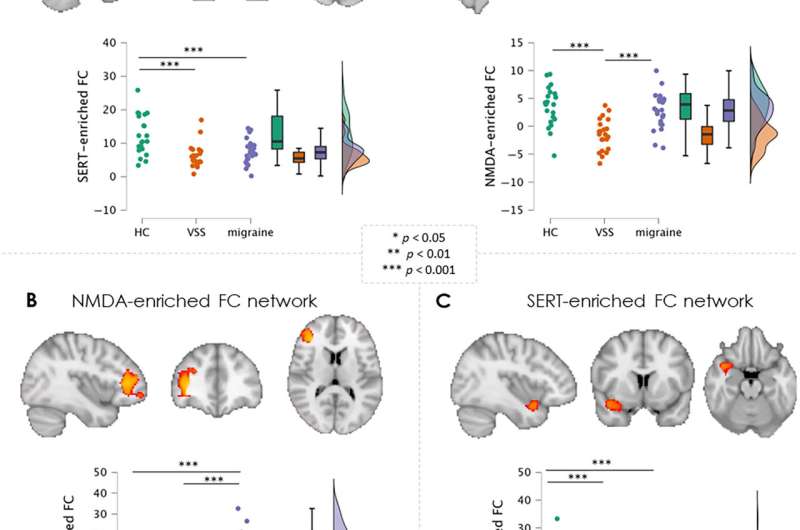This article has been reviewed according to Science X's editorial process and policies. Editors have highlighted the following attributes while ensuring the content's credibility:
fact-checked
peer-reviewed publication
trusted source
proofread
New brain scan study discovers possible biological basis of visual snow syndrome

Researchers from the Institute of Psychiatry, Psychology & Neuroscience (IoPPN) at King's College London have used a novel approach to show that the patterns of activity in two brain chemical systems—glutamate and serotonin—are different in people with visual snow syndrome compared to those without the condition.
Visual snow syndrome is characterized by a continuous visual disturbance in which people see static, flickering dots, and flashing lights—this happens when their eyes are both open and closed. It affects about 2 -3% of the world's population and it can be debilitating, impacting vision, hearing, thinking, sensory processing, and quality of life.
Researchers used existing scanning data from 24 patients with visual snow syndrome (VSS), 25 migraine patients and 24 healthy people with no VSS or migraine history. The brain scans were conducted at the NIHR King's Clinical Research Facility.
Currently there is no medication that is effective at helping people with VSS and the search for treatment has been hindered by lack of knowledge around the biology of the condition. Previous scanning studies in people with VSS have shown alterations in different regions of the brain and how these interact, however, there has been no research looking into the possible molecular changes that could underlie the condition. Further research into this area could provide insight into potential biological targets for treatment.
"Previous research has given us some insight into the brain regions involved in visual snow syndrome but our study is the first to identify the brain chemistry that could underlie the condition and other sensory experiences such as migraine aura. Until now there have been no effective treatments for VSS and importantly our research has confirmed that VSS is a neurological disorder with a chemical basis that could be used as a target for development of treatments," said Dr. Francesca Puledda, first author on the study and Senior Clinical Research Fellow at King's IoPPN
Using a new approach that was developed by researchers at the NIHR Maudsley BRC, the study combines information from positron emission tomography (PET) imaging information on the distribution of different chemical receptors in the brain with functional Magnetic Resonance Imaging (fMRI) analysis of the interaction of activity between different regions of the brain.
Using this Receptor-Enriched Analysis of Functional Connectivity by Targets (REACT) approach researchers can extract a map of activity of brain chemicals across the different brain areas. The five brain chemicals examined in this study were noradrenaline, dopamine, serotonin, glutamate and GABA.
Researchers found that in patients with VSS there were particular differences in the activity of glutamate and serotonin networks in specific areas of the brain. There was less synchronized activity (or functional connectivity) in the glutamate networks in the anterior cingulate cortex (ACC) in those with VCC compared to healthy controls and those with migraine. The ACC is a hub for thinking and top-down control over sensory inputs and the different pattern of activity could represent an interruption in the filtering and integration of visual information.
Analysis also showed that VSS patients had reduced functional connectivity in the serotonin networks of the visual cortex, insula, temporal pole and orbitofrontal areas of the brains compared to healthy controls. This reduced connectivity in serotonin networks was also seen in migraine patients with aura suggesting a biological link between VSS and aura. The findings suggest that serotonin activity in VSS patients may be influencing the integration of complex sensory information.
The results did not find any differences for the other brain chemicals that were investigated in the study.
The research is published in the journal Annals of Neurology.
More information: Francesca Puledda et al, Abnormal Glutamatergic and Serotonergic Connectivity in Visual Snow Syndrome and Migraine with Aura, Annals of Neurology (2023). DOI: 10.1002/ana.26745





















